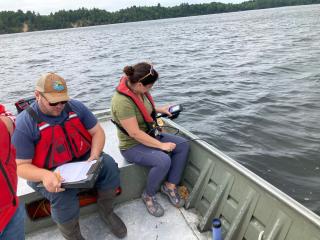2022 National Lakes Assessment focuses on upper Great Lakes states

MICHIGAN—“The upper area of the Midwest is home to 50% of the natural lakes in the U.S.,” said Trent Wickman of the Eastern Region. “The lakes are what make this a great place to live and draw visitors from all over the country. We really want to understand what is in the water, things like algae, nutrients and pollution, and use that data to determine how healthy the lakes are and to compare them to others.”
That’s why Wickman and Forest Service partners participate in the Environmental Protection Agency’s National Lakes Assessment. Conducted every five years, the assessment helps citizens and governments measure the health of waters across the nation. Data can be used to suggest ways to prevent pollution and evaluate the effectiveness of protection and restoration efforts. Researchers test enough lakes to create a data set that is statistically significant, totaling 904 lakes to represent the lower 48 states.
This year, Wickman wanted to look closer at the Northwoods’ ecoregion (Minnesota, Wisconsin and Michigan), to get a more detailed picture of the area. “Even though this national EPA study already broke the country into large ecological sections, there are smaller areas within those sections that have distinct ecosystems, which could also have unique chemical and biological characteristics,” he said.
Wickman shared his idea of an intensification of the national study with colleagues from the three states. Together, they proposed the idea to EPA, who then offered guidance on how to design the new aspect of the project.
Under the proposal, the eight most lake-rich sections in the Northwoods would be targeted for sampling, and each section would require a minimum of 30 lakes. The rest of the sections would be grouped into a single unit with 40 lakes to test.
To determine which lakes would be part of the Northwoods intensification, the EPA used a computer program to randomly select the sample. Only about half are located on National Forest System land. Wickman and his partners contacted other land managers to assemble a team who could work together on the various jurisdictions and share both the effort and scientific discovery. In total, around 20 agencies and organizations came together for the lake assessment survey.
Wickman and his colleagues began training scientists around the ecoregion on the purpose and methods for this survey. When he visited the Hiawatha National Forest in July, local team members were happy to pull on their boots and get in the boat. The crew included professionals from the Hiawatha National Forest, Chippewa, Luce and Mackinac County Conservation District, and the Michigan Department of Environment, Great Lakes and Energy.
“I’m excited that the Hiawatha is part of this landscape-level data collection effort,” said forest aquatic ecologist Lucas Langstaff. “The information collected will not only give us a look into the health of our inland lakes but also gives us perspective on how they compare to others on a broader scale.”
With 16 inland lakes on their list, the Hiawatha is sure to play a big role in the new study.
To learn more about the study, read the full story.

